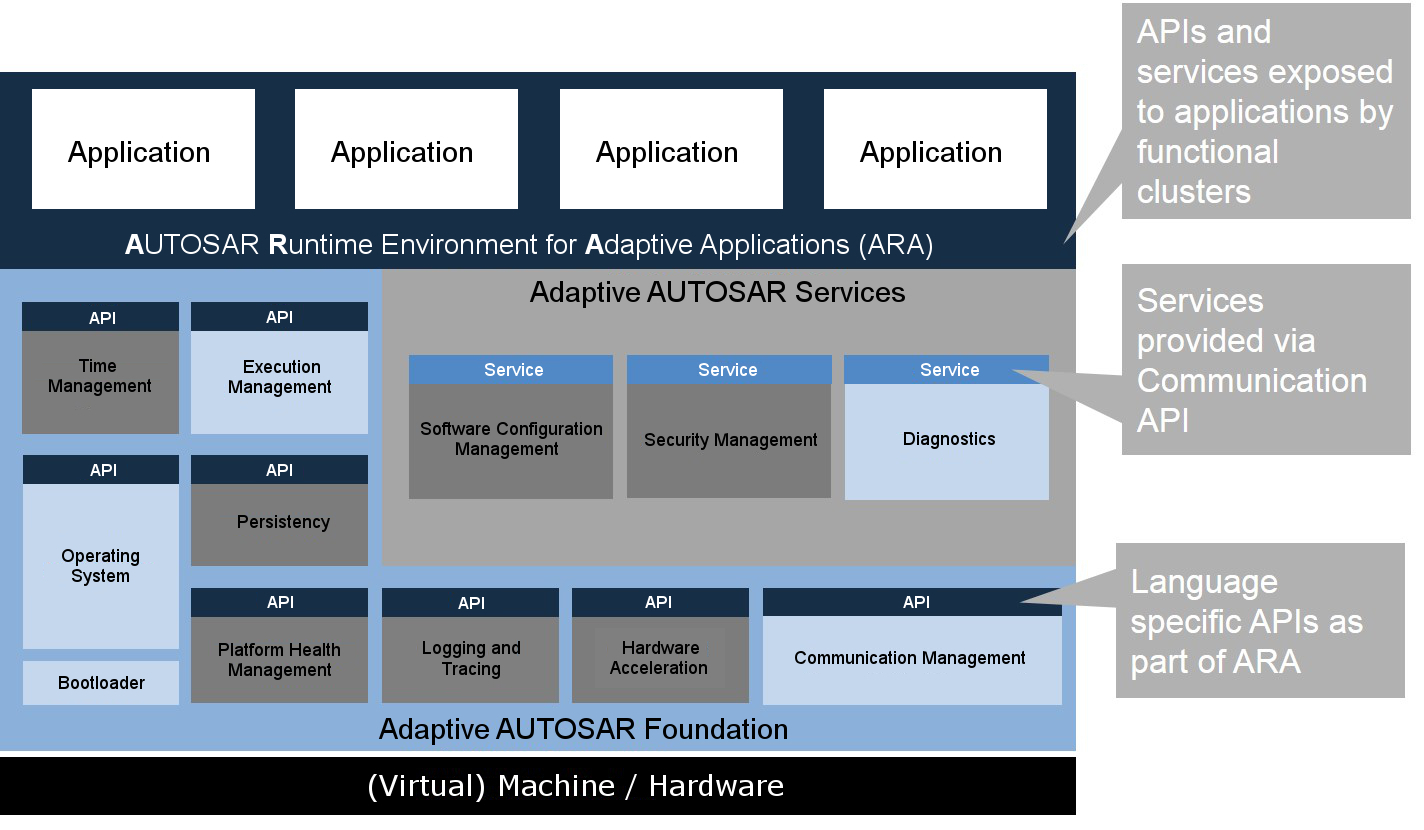 自适应AUTOSAR平台可以让一系列不同应用编程接口(API)与模块之间的通信更加简单随机。
自适应AUTOSAR平台可以让一系列不同应用编程接口(API)与模块之间的通信更加简单随机。
互联功能、高级安全功能和自动驾驶功能,都将改变未来汽车的电子架构,这是因为这些功能采用的控制器之间的通信更加随机,并不像当今绝大多数模块那么固定。正因如此,汽车开放系统架构(AUTOSAR)组织计划推出一套新的标准,以适应更加多变的通信模式。
新标准名为自适应AUTOSAR平台(AUTOSAR Adaptive Platform)。该平台经过专门研发,可以为工程师的架构设计提供更大的灵活性,预计将于2017年完成。自适应AUTOSAR平台将为复杂性更高的系统提供一个软件框架,帮助工程师利用以太网络(Ethernet)增加带宽。
“通过新的自适应平台,AUTOSAR旨在为新的应用提供一个最优的标准化软件框架,特别是对于汽车互联、高度自动化和自动驾驶领域的应用。”AUTOSAR组织发言人Stefan Rathgeber表示,“可以通过一些途径,比如以太网,将经典应用和自适应性应用进行无缝衔接。”
未来的汽车架构将更具多样性,信息娱乐系统和高级驾驶协助系统(ADAS)等电子架构势必会对车辆的通信功能提出更高需求,这样才能保证不同模块之间的快速交互,从而提供专用模块无法独立处理的特性和功能。电子控制和通信系统的快速发展,提高了汽车行业对AUTOSAR的接受程度。经过升级的新平台可以扩充现有标准的适用范围。
新标准或将率先登陆ADAS系统
“自适应AUTOSAR平台并不是AUTOSAR的替代品,认识到这一点非常重要,”Elektrobit汽车基础设施软件系统工程部负责人Alexander Much表示,“目前,汽车的架构几乎没什么变化,制动和转向模块必须向节点发送大量消息,这些节点还必须‘了解’各个单元及其所处位置。”他说,“未来的汽车架构可能更加自由,节点无需了解正在进行通信的计算机处于什么位置,或是将传递什么信息。”
新标准很可能最先应用至高级驾驶辅助系统(ADAS),还能为标准操作系统无缝整合更多的互联功能和图像处理能力,从而协助信息娱乐系统的开发。
“短期来看,自适应AUTOSAR平台将更多集中在高级驾驶员协助系统方面的需求。”Vector CANtech嵌入式软件北美产品线总监Kurt Krueger表示,“高度自动驾驶系统必须非常可靠,具备故障安全(fail-safe)运行的能力,而实现这一点,必须依靠高性能的微控制器、强大的运算能力,以及高速的数据传输。”
这些系统将为自动驾驶的到来铺平道路,无人驾驶汽车领域正是新平台利用自身强项,发挥最大作用的舞台。
Rathgeber解释道,自适应AUTOSAR平台经过专门设计,可以满足自动驾驶的关键需求,支持高速数据处理、“服务向”通信功能和“空中”升级等功能。他补充说,AUTOSAR致力于尽量让更多厂商、供应商和开发者采用这套统一标准,从而在通往自动驾驶的道路上扮演关键使能角色。
AUTOSAR开发委员会的目标之一是打造一个动态系统,该系统将内含“中间件(middleware)”,且能通过Posix接口和多核微处理器支持复杂操作系统。该平台主要通过“服务向”通信和IP/以太网实现通信功能,未来可以支持自适应性软件应用,也可以与非AUTOSAR系统进行交互。
开发项目正在加码
目前,大多数供应商似乎都有兴趣快速行动,尽快完成实施新标准。该平台预计将作为一种道路基础设施,服务于自动驾驶汽车。
Much表示,“所有厂商都需要朝自动驾驶汽车方向去努力,因此他们急需这套标准。”
新标准的开发者指出,最早发行的1.0.0版标准将提供一组满足最低要求的功能。Rathgeber表示,随后开发人员还将根据市场需求和用户反馈,在相对较短的发布周期内,不断为标准增加新的功能。目前,许多公司已经开始大力推动相关研发项目,因此新标准可能很快就能登陆量产车型。
“自适应AUTOSAR平台的部分功能最早将于2019/2020年出现在公路上。”Krueger表示,“我们认为2022年后,这一标准在生产中的应用将更加普遍。”
作者:Terry Costlow
来源:SAE《汽车工程》杂志
翻译:SAE 上海办公室
New AUTOSAR platform offers more freedom for vehicle electrical architectures
Connectivity, advanced safety and autonomy are all altering electronic architectures, since they utilize controllers that communicate with each other more randomly than the fairly set links between current-day modules. That’s prompted the Automotive Open System Architecture (AUTOSAR) development partnership to come up with a new standard that adapts to changeable communication patterns.
The AUTOSAR Adaptive Platform, currently set for completion in 2017, is designed to help engineers create more flexible architectures. AUTOSAR Adaptive will provide a software framework for more complex systems and help engineers increase bandwidth by implementing Ethernet.
“With the new Adaptive Platform, AUTOSAR aims to provide an optimal standardized software framework for new applications, especially in the fields of connectivity and highly automated and autonomous driving,” said Stefan Rathgeber, spokesperson for the AUTOSAR development partnership. “Classic and adaptive applications can be seamlessly combined, for example via Ethernet.”
In forthcoming architectures as diverse as infotainment and advanced driver assistance systems (ADAS), more communication will be necessary so modules can interact quickly to provide features and functions that can’t be handled by dedicated modules alone. The rapid increase in electronic controls and communications has fueled growing acceptance of AUTOSAR. The new upgrade augments existing usage of the standard.
New standard likely to debut in ADAS
“It’s important not to think of AUTOSAR Adaptive as a replacement for AUTOSAR,” said Alexander Much, head of software systems engineering for car infrastructure atElektrobit. “Currently, vehicles have very static vehicle architectures where brake and steering modules send a lot of messages to nodes that 'know' who and where all the units are," he said. "Now, more dynamic things are coming, where nodes don’t need to know where computers they are communicating with are located or when they’re going to transmit.”
The new standard will probably see its first application in advanced driver assistance systems (ADAS). It can also aid infotainment system development by providing a more seamless integration into a standard operating system with more connectivity and graphics computing power.
“AUTOSAR Adaptive will concentrate a bit more on ADAS needs in the short term,” said Kurt Krueger, North American Product Line Director for Embedded Software atVector CANtech. “Highly automated driving systems must be dependable and have fail-safe operational capabilities. This can only be accomplished with high-performance micro-controllers, computing power, and high data transfer rates.”
These systems are paving the way for autonomous driving. The driverless car is where the new platform’s strengths will ultimately provide the greatest benefits.
Designed to meet key requirements with regard to autonomous driving, the AUTOSAR Adaptive Platform comes with features such as high data processing capacities, service oriented communication and updates over the air, Rathgeber explained. He added that AUTOSAR strives to be a key enabler on the way to the self-driving car by making the new platform accessible to as many manufacturers, suppliers and developers as possible.
Among the development committee’s goals is to create a dynamic system that includes middleware and supports complex operating systems using a Posix interface and multicore microprocessors. Its main communication approach is based on service-oriented communication and IP/Ethernet. The platform will be capable of supporting adaptive software deployment while interacting with non-AUTOSAR systems.
Development programs ramping up
Most suppliers currently seem to be interested in moving fairly quickly to get the standard completed and implemented. It’s expected to become a piece of the in-vehicle infrastructure used on the road to autonomous vehicles.
“All the OEMs need to go on the road with autonomous vehicles, so they need this quickly,” Much said.
The developers of the new standard note that the initial 1.0.0 release will offer a set of minimum required features. Enriched features based on market requirements and user feedback are expected to be added with comparatively short release cycles, Rathgeber said. Many companies are already ramping up their development programs so implementation in production vehicles may begin fairly soon.
“The first parts of AUTOSAR adaptive may appear on highways as early as 2019/2010,” Krueger said. “Vector expects a more general adoption of AUTOSAR adaptive for production by 2022 and later.”
Author: Terry Costlow
Source: SAE Automotive Engineering
等级
打分
- 2分
- 4分
- 6分
- 8分
- 10分
平均分
- 作者:Terry Costlow
- 行业:汽车
- 主题:电气电子与航空电子
